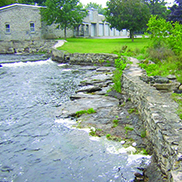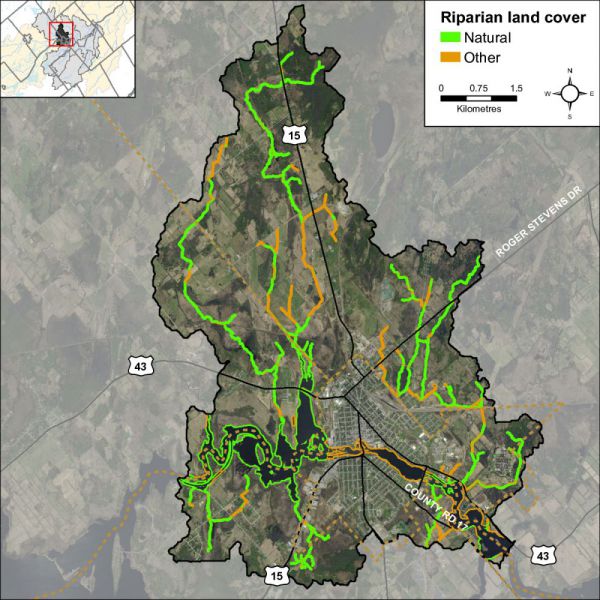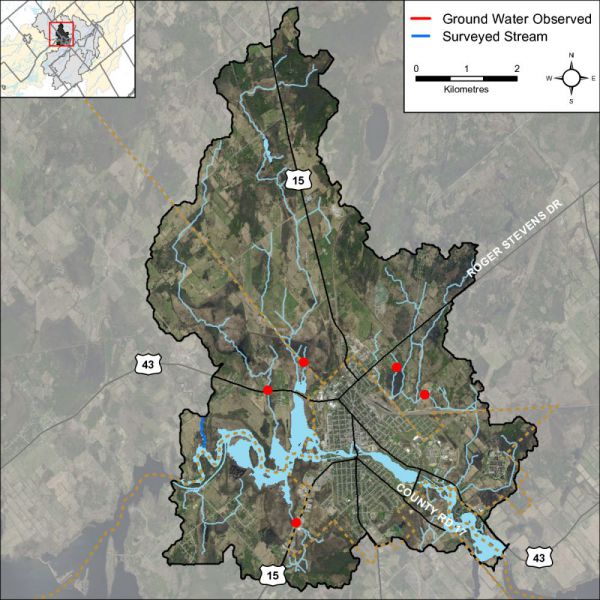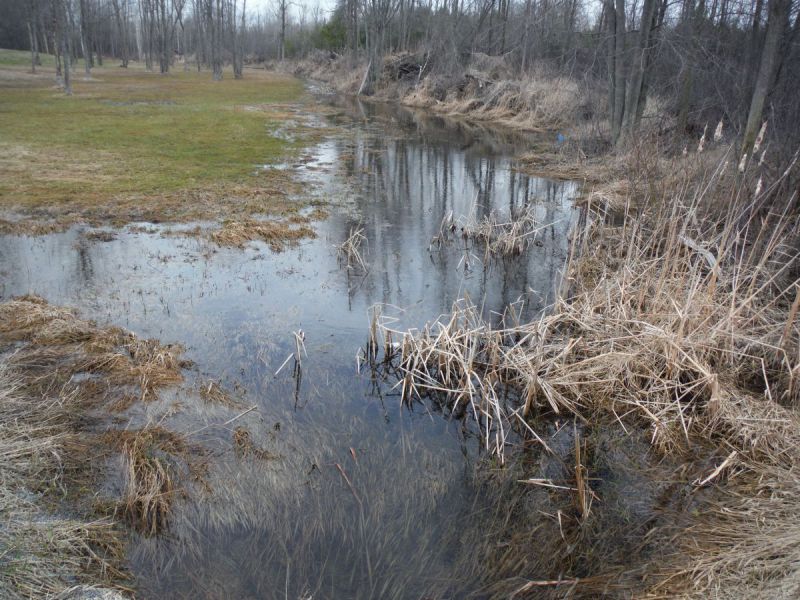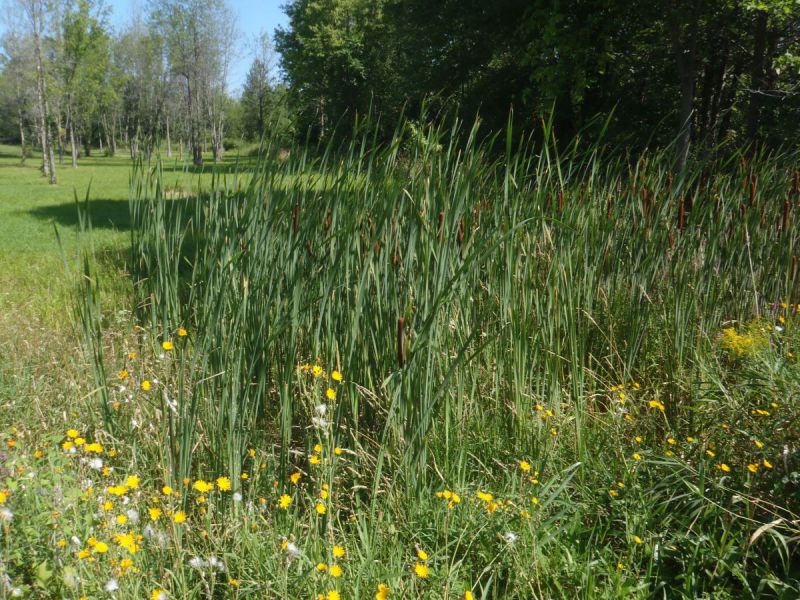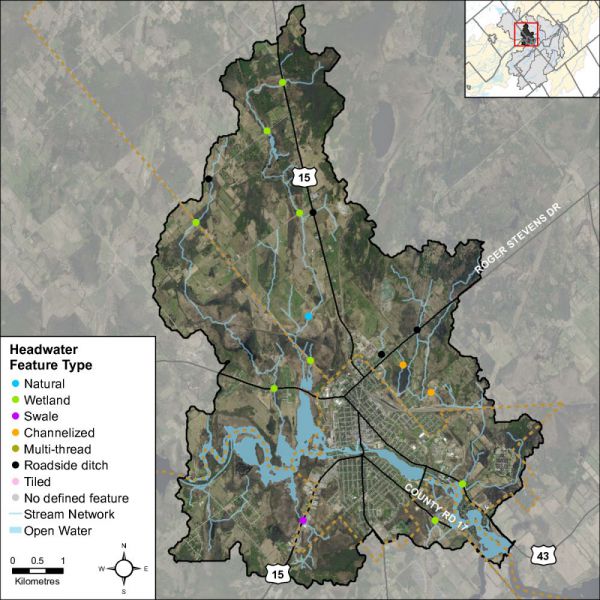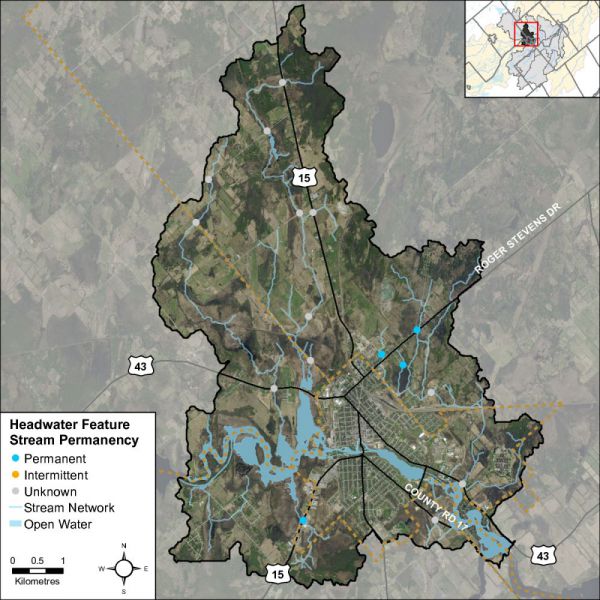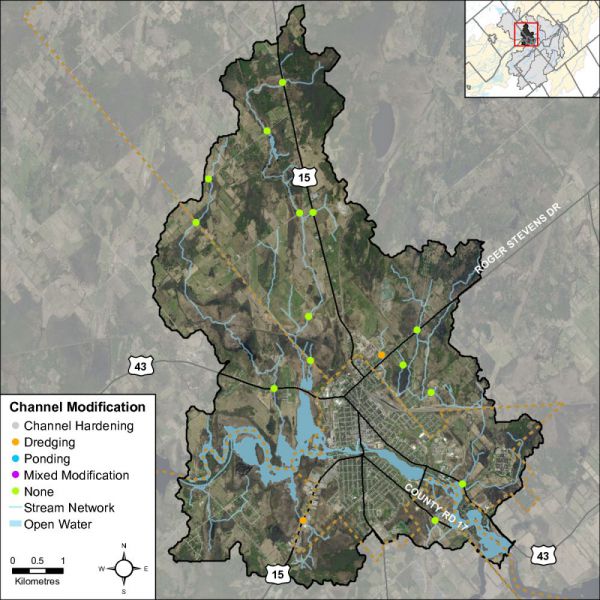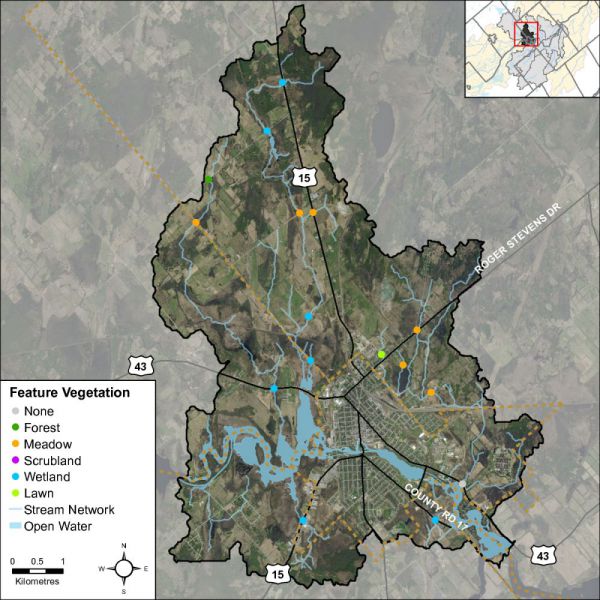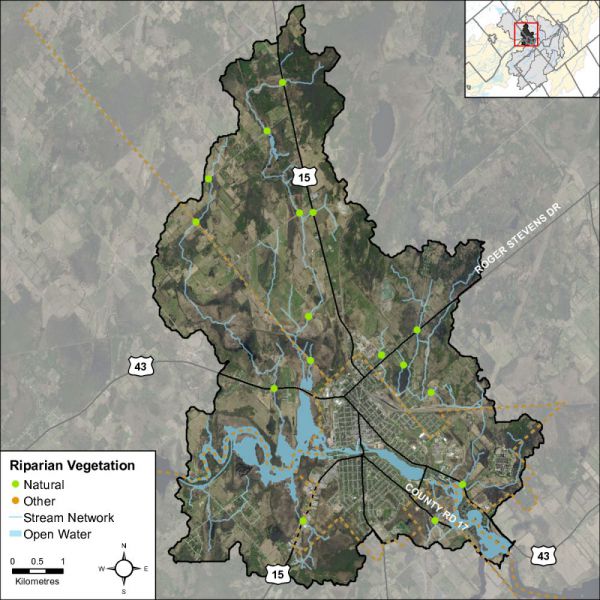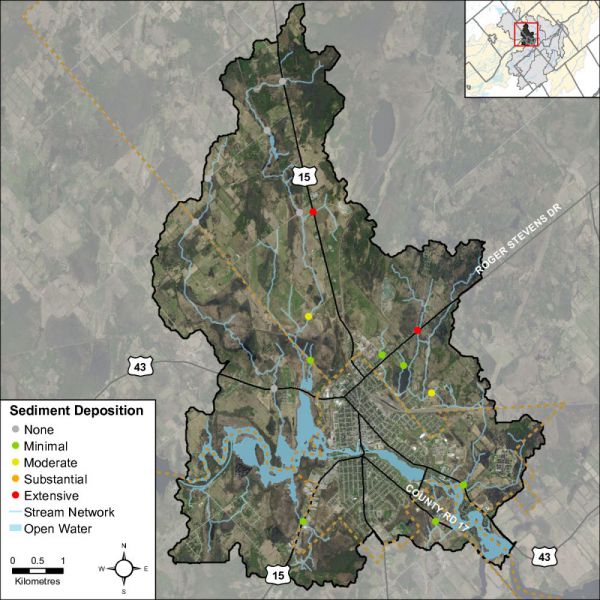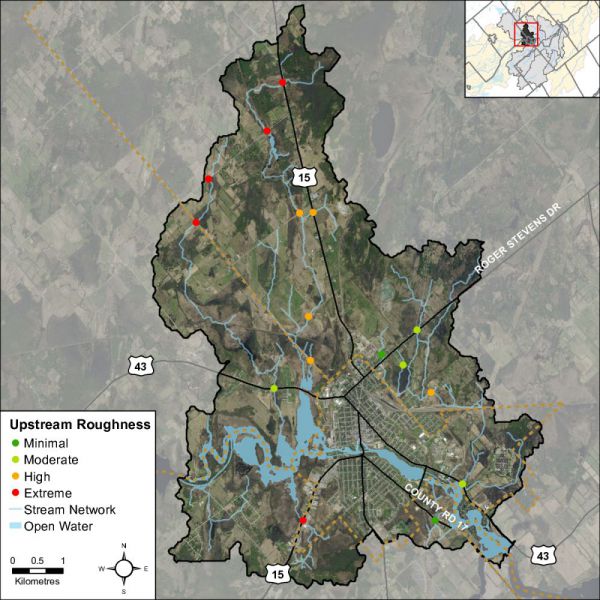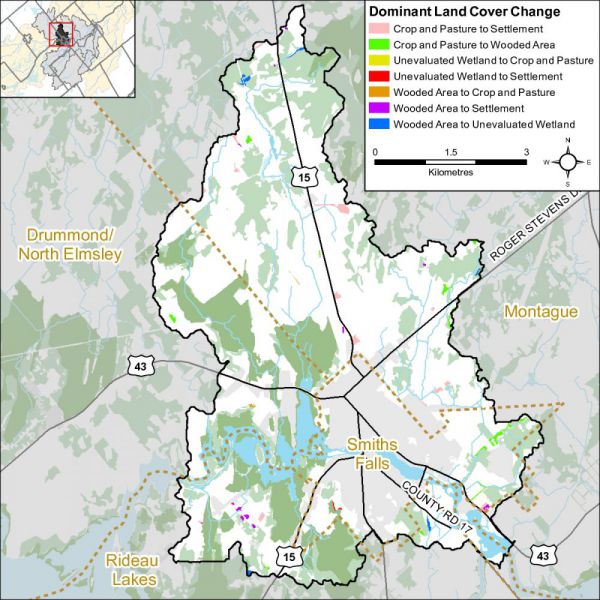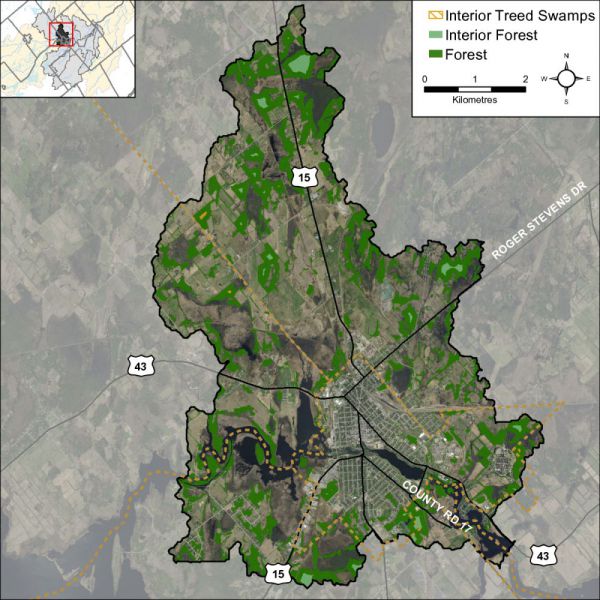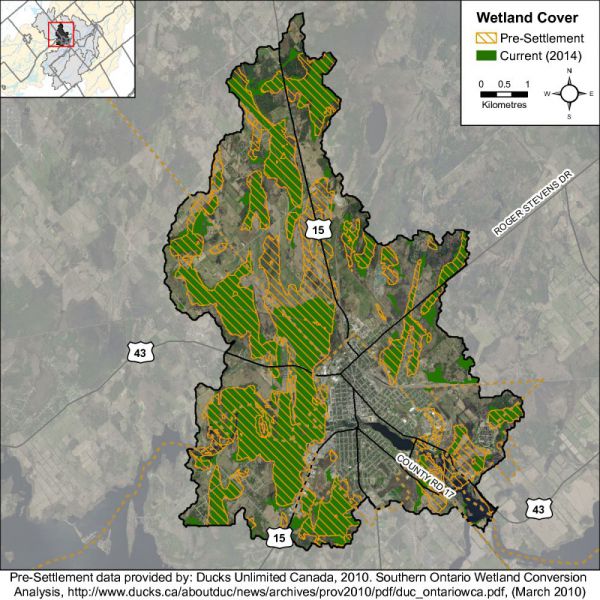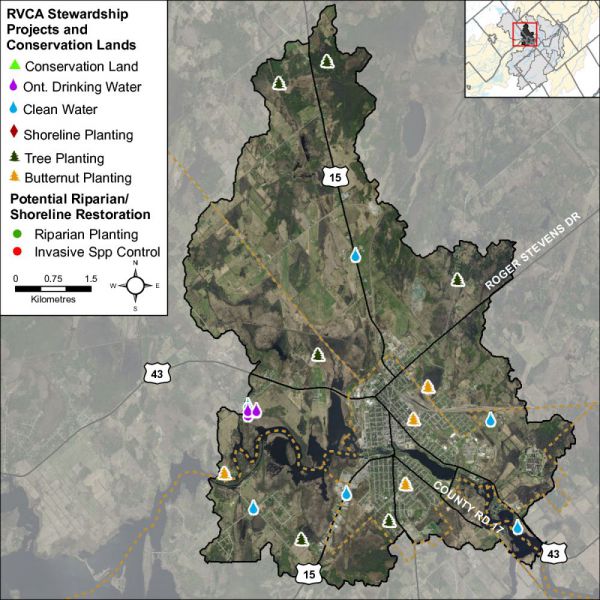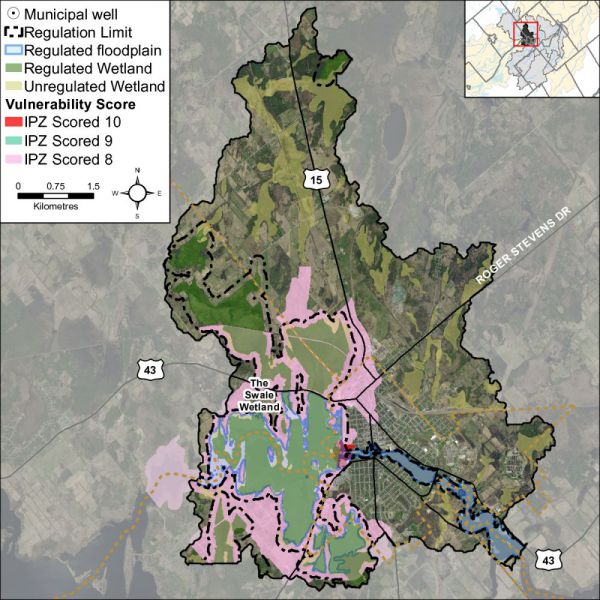Middle Rideau Subwatershed Report 2015
RIDEAU-SMITHS FALLS CATCHMENT
The RVCA produces individual reports for ten catchments about environmental conditions in the Middle Rideau subwatershed using data collected and analysed by the RVCA through its watershed monitoring and land cover classification programs every six years.
This information is used to better understand the effects of human activity on our water resources, allows us to better track environmental change over time and helps focus watershed management actions where they are needed the most to help sustain the ecosystem services (cultural, aesthetic and recreational values; provisioning of food, fuel and clean water; regulation of erosion/natural hazard protection and water purification; supporting nutrient/water cycling and habitat provision) provided by the catchment’s lands and forests and waters (Millennium Ecosystem Assessment 2005).
The following pages of this report are a compilation of that work and contain information on surface water quality, riparian conditions, land cover, stewardship activity and hazard land and water resources protection.
1. Catchment Facts
General Geography
- The Rideau River flows through the heart of the Middle Rideau and is a focal point for residents and visitors to the area. It extends from the outlet of Lower Rideau Lake at Poonamalie (where there is one dam and one lock) to Burritts Rapids (where there is also a dam and lock), at which point it enters the Lower Rideau on its way to Rideau Falls. The Rideau River is a designated Canadian Heritage River and an integral part of the Rideau Canal National Historic Site of Canada that is a UNESCO World Heritage Site and a major tourist attraction. Smiths Falls, Merrickville and Burritts Rapids are the main settlements in the subwatershed
- The Town of Smiths Falls is the main settlement with other areas of the catchment being predominantly rural in character and agriculture a major land use
- In the Town of Smiths Falls, the vast majority of the shoreline lands of the Rideau River and Canal within the Town boundary are publically owned, either by the Town or Federal Crown agencies and are used for recreational purposes linked to the use of the Rideau Canal. The Upper Basin of the Canal is a primarily structured shoreline with original canal limestone walls. A small portion of the north shore of the Upper Basin is a beached swimming area for tourists and docking areas are provided for users of the Canal between the Detached and Combined lock stations. The Lower Basin of the Canal is a mixture of structured and unstructured shoreline. The north shore of the Lower Basin remains in the ownership of the Crown up to the high water line after which the lands are privately owned. The southern shore of the Lower Basin is former landfill which has been capped and repurposed as municipal parkland
- Parks Canada staff manage water levels for recreational purposes along the Rideau Canal/Waterway that runs through the catchment, ensuring 1.5 metres of draft during the navigation season. In this managed system, water levels on the Rideau Canal are manipulated by operation of numerous dams. In the Middle Rideau subwatershed, Parks Canada staff operate 9 dam and lock complexes with 13 locks for a fall of 36.2 metres over 35.6 kilometres. Water levels are maintained as close as possible to set objectives through the May to October navigation season. The levels are lowered through the rest of October and into November and held at the winter levels until the spring freshet in late March or early April naturally increases inflows to the system. To reduce the impact of the higher flows in the spring, the amount of snow water equivalent, forecast rain, ice cover, flows and levels are assessed and the dams in the Middle Rideau reach are operated accordingly to quickly pass as much water as possible. In late April and early May, the dams are gradually closed and water levels are brought up to be ready, once again, for the navigation season
Physical Geography
- All of Rideau-Smith Falls catchment and the rest of the Middle Rideau subwatershed primarily resides within the Smith Falls Limestone Plain, which in this area is primarily made up of March Formation sandstone and dolostone. The bedrock across the catchment is mainly overlain by a thin veneer of glacial sediment, referred to as ‘drift’ that is generally less than a metre in thickness; although there are significant areas of glacial till and organic deposits
- Forty-six percent of the catchment lies within the Township of Montague, 20 percent in the Town of Smiths Falls, 18 percent in the Township of Drummond/North Elmsley, 15 percent in the Township of Rideau Lakes and one percent in the Village of Merrickville-Wolford
- Rideau-Smiths Falls catchment drainage area is 48 square kilometres and occupies about six percent of the Middle Rideau subwatershed and one percent of the Rideau Valley watershed
Vulnerable Areas
- The Assessment Report developed under the Ontario Clean Water Act identified the catchment area as a Highly Vulnerable Aquifer and the Town of Smiths Falls municipal drinking water source as an Intake Protection Zone, which is subject to mandatory policies in the Mississippi-Rideau Source Protection Plan that specifically regulate land uses and activities that are considered drinking water threats, thereby reducing the risk of contamination of the municipal drinking water source
- Lands along the Rideau River in the catchment are subject to flooding during the regional (100 year) storm. Flood elevations for this section of the Rideau River range from 123.16 metres above mean sea level (masl) downstream of the Poonamalie Dam, to 121.52 masl below Abbot Street, to 112.4 masl downstream of Beckwith Street, to 106.8 masl upstream of the Edmonds Lock
Development/Trends
Town of Smiths Falls
- Is a predominantly serviced urban municipality that has established mandatory service connections for properties subject to intensification and redevelopment on the fringe development areas where there are approximately 40 properties remaining without full services
- Is classified into five primary development categories in the 2014 Official Plan: Residential, Commercial, Major Institutional, Mixed-Use, Industrial, and Open Space
- Generally speaking has had historic new development occurring on fringe greenfield sites. Three developments in particular have been recently approved for the construction of mixed density residential communities in the south-western quadrant of the municipality (Ferrara Meadows, Bellamy Farms, and Wood Avenue). These sites are within the influence area of Lousy Creek, a tributary to the Rideau Canal, and adjacent to areas of Provincially Significant Wetland. All three developments have been subject to extensive Environmental Impact Studies and Water Budget Assessments, reviewed and approved by the Rideau Valley Conservation Authority
- Has adopted a mandate of intensification and adaptive reuse in the new 2014 Official Plan to guide development to better utilize existing lands rather than consuming greenfield lands. Sites such as the Rideau Regional Centre, the former South Unit Hospital, and various vacant land parcels in established neighbourhoods will be prioritized for development
- Has the majority of land along the shoreline of the Rideau River and Canal presently developed, however there are several sites at the Combined Lock Station that have been identified for re-development. These sites include: The former Water Treatment Plant; the EconoLodge; the former Canadian Tire shopping centre; and the Parks Canada Gate Shop. These properties are believed to be potential Brownfield sites, as the lands were historically used by the Frost & Wood Implement Manufacturing Company
- Has The Swale as an area of Provincially Significant Wetland on the western boundary of the Town (SF) and the Townships of Rideau Lakes (RL) and Drummond/North Elmsley (DNE). Existing development around the Swale include: a golf course (DNE), Year-round Trailer Park (DNE) Highway Commercial Development (RL/SF), Big Box Commercial (SF), light residential (SF), existing in-water boat houses (SF) and Institutional/Office uses (SF). One particular property adjacent to the Swale is operated by the Rideau Environmental Action League. REAL has expressed a keen interest to develop shoreline lookouts and interpretive centres as part of a site restoration plan for the former industrial lands. Discussions with both Parks Canada and RVCA have been ongoing
- Has prepared Conceptual Plans for the redevelopment and revitalization of its Waterfront as has been well documented in the Town of Smiths Falls Downtown Revitalization and Waterfront Integration Master Plan. The Plan calls for the provision of public access to the waterfront, and naturalization of the shoreline where feasible
Drummond/North Elmsley
- Residential development is generally very scattered with single family residences and no major subdivisions. Along County Road 43 to the west of Smiths Falls, there are some commercial and industrial uses and a greater concentration of single family residences. Elsewhere, other non-residential and non-agricultural uses are small and typically oriented locally to the farming sector
Montague
- Development is concentrated mostly on the periphery of Smiths Falls with older subdivisions on municipal services (Atironto and Carswell) taking on a more urban pattern of development. These subdivisions (especially along the Roger Stevens Road corridor) contain most of the established commercial and industrial development in the Township. North of Smiths Falls, along Highway 15, is a significant amount of industrially zoned land, however to date it is largely undeveloped. The rural remainder of the Township consists of scattered residential and agricultural development, mostly along traditional transportation routes and in areas of good agricultural capability
Rideau Lakes
- Land use is predominately Rural (RU) and Agricultural (A) with some areas of Rural Estate Lot Subdivision (RG) located to the south of Smiths Falls, off the Poonamalie Road
Conditions at a Glance
Instream and Riparian
- In the Rideau-Smiths Falls catchment, the riparian buffer (30 m. wide strip along the shoreline of the Rideau River and its tributaries) is comprised of wetland (56 percent), crop and pastureland (15 percent), woodland (11 percent), settlement areas (11 percent) and transportation routes (seven percent)
- In the Town of Smiths Falls, the 30 metre riparian buffer is comprised of wetland (33 percent), commercial, industrial, institutional and residential areas (33 percent), woodland (14 percent), roads/railways (11 percent) and crop and pastureland (nine percent)
- Along the Rideau River and Canal through the Town of Smiths Falls, the 30 metre wide riparian buffer contains commercial, institutional and residential areas (59 percent), wetland (19 percent), roads, railways and lock stations (12 percent) and woodland (10 percent)
Land Cover
- Rideau-Smiths Falls catchment land cover is dominated by crop and pastureland (28 percent) and wetland (27 percent) followed by settlement areas (18 percent), woodland (17 percent), transportation routes (seven percent), water (two percent) and aggregate sites (one percent). From 2008 to 2014, there was an overall land cover change of 42 hectares (from one land cover class to another) in the catchment, most of which can be attributed to the conversion of “crop and pasture” to newly developed ‘settlements’ and emerging ‘wooded areas’ (plantations or early successional woodlands)
- Town of Smiths Falls land cover is dominated by commercial, industrial and residential areas (44 percent) followed by roads and railways (18 percent), woodland (16 percent), crop and pastureland (11 percent), wetland (eight percent) and water (three percent). From 2008 to 2014, the overall land cover change was 12 hectares, mostly attributable to the conversion of “crop and pasture” to emerging ‘wooded areas’ (plantations or early successional woodlands) and new development
- Woodland cover in the catchment has increased by 11 hectares between 2008 and 2014 and interior forest habitat has increased by one hectare. In the Town of Smiths Falls, the overall area of woodland has increased by six hectares between the two reporting periods and interior forest habitat has increased by one hectare
- Wetland cover has decreased by 10 percent (468 ha) from pre-settlement times to the present and now occupies 27 percent of the catchment area
Other
- Approximately 930 to 990 in-use water wells with provincial records in this catchment. While most water wells are used for domestic water supply, in this catchment, many are also used for commercial, industrial, agricultural, municipal and public water supplies; monitoring wells; cooling systems; or dewatering
- Numerous Environmental Compliance Approvals have been issued in this catchment for discharge to the environment related to municipal, private and industrial sewage works and industrial and commercial air emissions
- Several Permits to Take Water have been issued in this catchment for the Smith Falls (surface) water supply wells and for local industrial cooling operations
- There is one large bedrock aggregate license in this catchment along with one sand and gravel pit license
Catchment Care
- Twenty stewardship projects have been completed with assistance from the RVCA’s Rural Clean Water and Tree Planting Programs and Ontario Drinking Water Stewardship Program (please see Section 4 of this report for details)
- The Town of Smiths Falls has installed both its primary intake and backup intake in the Rideau River at Abbott Street and is acutely aware of potential drinking water threats from adjacent land uses. This has led to the area around the Rideau Canal Detached Lock Station (at Abbott Street) being identified as an “Intake Protection Zone 10” in both the Mississippi-Rideau Sourcewater Protection Plan and the Town of Smiths Falls Official Plan. The Town is the first municipality in the MRSPP jurisdiction to adopt stringent Official Plan policies for the protection of its drinking water supply and will be adopting similar provisions in the Zoning Bylaw
- The Smiths Falls 2034 Official Plan (p.9) serves as the Town’s latest expression of its ongoing commitment to a leadership role in the advancement of an innovation-based economy, the development and implementation of environmental policies, and the utilization of land use planning best practices to shape Smiths Falls’ future. The Plan includes land use policies to shape the transformation of strategically identified and historically underutilized areas into higher-density, mixed-use areas, which can accommodate employment and housing growth and reduce the environmental impacts of that growth by promoting cycling and walkability. Some specific objectives of the Town’s “Environmental Vision” for a “healthy and sustainable environment” are listed below, which help to define and unify the vision for a thriving community and are intended to be implemented by the following policies set out in the Official Plan (p.10, 11):
- Conservation of resources including energy, water, wetlands, wildlife, habitat, biodiversity, and other natural resources
- Protection of natural features and areas for the long term
- Responsible stewardship for open lands and natural areas
- A connected system of open lands
- Healthy urban watershed and ongoing best-practices to floodplain management
- Source water protection for a safe and lasting water supply and drinking water quality
- Local and regional cooperation, coordination, and leadership on environmental matters
- The Town of Smiths Falls is committed to the preservation, protection and restoration of the ecological integrity and scenic characteristics of The Swale Provincially Significant Wetland which is an identified life science area of natural and scientific interest, as well as an important feature of the UNESCO Rideau Canal
- Smiths Falls is committed to responsible stormwater management to support healthy habitats, a healthy human population and a healthy economy
- A watershed model developed by the RVCA in 2009 was used to study the hydrologic function of wetlands in the Rideau Valley Watershed, including those found in the Rideau-Smiths Falls catchment
- The Townships of Drummond-North Elmsley, Montague, Rideau Lakes and the Town of Smiths Falls work with individual property owners on a case by case basis to enable new development and redevelopment while ensuring the scale is suitable for the property, impacts on neighbours are minimized and natural features/hazards, when identified, are protected. Naturalized shorelines are generally negotiated through site plan control and subdivision consent applications, during which time municipal staff work with Parks Canada and the RVCA to harmonize the approvals process
- Development in and adjacent to the Provincially Significant Wetlands in the catchment (The Swale and some locally significant wetlands) are subject to Ontario Regulation 174-06 (entitled “Development, Interference with Wetlands and Alterations to Shorelines and Watercourses”) that protects the hydrologic function of the wetland and also protects landowners and their property from natural hazards (flooding, fluctuating water table, unstable soils) associated with them
- The report entitled “A Multidisciplinary, Community-Based Study of the Environmental Health of the Rideau River” was prepared by the Canadian Museum of Nature in 2001. The study’s goals were to assess the biodiversity of the Rideau River, from Smiths Falls to Ottawa, and to reconcile local needs with long-term sustainable management of its biological diversity
- Rideau Canal National Historic Site of Canada Management Plan (2005) update establishes the long term strategic direction for the management of the Rideau Canal and the Rideau Canal World Heritage Site Management Plan (2005) specifies how its world heritage values will be protected for present and future generations
- The Landscape Character Assessment Report identifying key features and visual values along the Rideau Canal was released by the Rideau Corridor Landscape Strategy Steering Committee in April 2013 and includes recommendations for future planning and management actions to protect the visual setting of the Rideau Canal from Ottawa to Kingston, including those found in the Rideau-Smiths Falls catchment
2. Rideau River Tributary Riparian Conditions
Shoreline Buffer Land Cover Evaluation
The riparian or shoreline zone is that special area where the land meets the water. Well-vegetated shorelines are critically important in protecting water quality and creating healthy aquatic habitats, lakes and rivers. Natural shorelines intercept sediments and contaminants that could impact water quality conditions and harm fish habitat in streams. Well established buffers protect the banks against erosion, improve habitat for fish by shading and cooling the water and provide protection for birds and other wildlife that feed and rear young near water. A recommended target (from Environment Canada’s Guideline: How Much Habitat is Enough?) is to maintain a minimum 30 metre wide vegetated buffer along at least 75 percent of the length of both sides of rivers, creeks and streams.
Figure 1 shows the extent of the naturally vegetated riparian zone along a 30 metre wide strip of shoreline of the Rideau River and its tributaries. This information is derived from a dataset developed by the RVCA’s Land Cover Classification Program through heads-up digitization of 20cm DRAPE ortho-imagery at a 1:4000 scale, which details the catchment landscape using 10 land cover classes.
Figure 1 Natural and other riparian land cover in the Rideau-Smiths Falls catchment
This analysis shows that the Rideau-Smiths Falls catchment riparian buffer is comprised of wetland (56 percent), crop and pastureland (15 percent), woodland (11 percent), settlement areas (11 percent) and roads/railways (seven percent). In the Town of Smiths Falls, the riparian buffer is comprised of wetland (33 percent), commercial, industrial, institutional and residential areas (33 percent), woodland (14 percent), roads/railways (11 percent) and crop and pastureland (nine percent) and along the Rideau River and Canal itself (in the Town), the shoreline buffer is made up of commercial, institutional and residential areas (59 percent), wetland (19 percent), transportation routes (12 percent) and woodland (10 percent). Additional riparian statistics for the Rideau-Smiths Falls catchment are presented in Table 1 to Table 3 and show that there has been very little to no change in shoreline cover from 2008 to 2014.
Table 1 Riparian land cover (2008 vs. 2014) in the Rideau-Smiths Falls catchment
Table 2 Riparian land cover (2008 vs. 2014) in the Town of Smiths Falls
Table 3 Riparian land cover (2008 vs. 2014) in Smiths Falls along the Rideau River and Canal
Rideau River Tributary Instream Aquatic Habitat
Groundwater
Groundwater discharge areas can influence stream temperature, contribute nutrients, and provide important stream habitat for fish and other biota. During stream surveys, indicators of groundwater discharge are noted when observed. Indicators include: springs/seeps, watercress, iron staining, significant temperature change and rainbow mineral film. Figure 2 shows areas where one or more of the above groundwater indicators were observed during stream surveys and headwater assessments.
Figure 2 Groundwater indicators observed in the Rideau-Smiths Falls catchment
Headwaters Drainage Features Assessment
The RVCA Stream Characterization program assessed Headwater Drainage Features for the Middle Rosedale subwatershed in 2014. This protocol measures zero, first and second order headwater drainage features (HDF). It is a rapid assessment method characterizing the amount of water, sediment transport, and storage capacity within headwater drainage features (HDF). RVCA is working with other Conservation Authorities and the Ministry of Natural Resources and Forestry to implement the protocol with the goal of providing standard datasets to support science development and monitoring of headwater drainage features. An HDF is a depression in the land that conveys surface flow. Additionally, this module provides a means of characterizing the connectivity, form and unique features associated with each HDF (OSAP Protocol, 2013). In 2014 the program sampled 16 sites at road crossings in the Rideau - Smiths Falls catchment area (Figure 3).
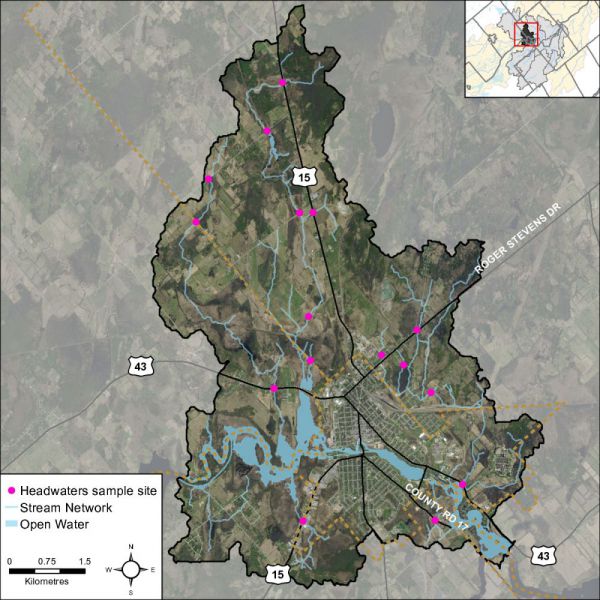
Figure 3 Locations of the headwater sampling sites in the Rideau-Smiths Falls catchment
Spring photo of a headwater sample site in the Rideau-Smiths Falls catchment located on Harper Condie Road
Summer photo of a headwater sample site in the Rideau - Smiths Falls catchment located on Harper Condie Road
Feature Type
The headwater sampling protocol assesses the feature type in order to understand the function of each feature. The evaluation includes the following classifications: defined natural channel, channelized or constrained, multi-thread, no defined feature, tiled, wetland, swale, roadside ditch and pond outlet. By assessing the values associated with the headwater drainage features in the catchment area we can understand the ecosystem services that they provide to the watershed in the form of hydrology, sediment transport, and aquatic and terrestrial functions. The Rideau-Smiths Falls catchment is dominated by wetland headwater drainage features. Two features were classified as having been channelized, one was identified as a swale and four features were identified as roadside drainage features. Figure 4 shows the feature type of the primary feature at the sampling locations.
Figure 4 Headwater feature types in the Rideau-Smiths Falls catchment
Headwater Feature Flow
The observed flow condition within headwater drainage features can be highly variable depending on timing relative to the spring freshet, recent rainfall, soil moisture, etc. Flow conditions are assessed in the spring and in the summer to determine if features are perennial and flow year round, if they are intermittent and dry up during the summer months or if they are ephemeral systems that do not flow regularly and generally respond to specific rainstorm events or snowmelt. Flow conditions in headwater systems can change from year to year depending on local precipitation patterns. Figure 5 shows the observed flow conditions at the sampling locations in the Rideau-Smiths Falls catchment.
Figure 5 Headwater feature flow conditions in the Rideau-Smiths Falls catchment
Feature Channel Modifications
Channel modifications were assessed at each headwater drainage feature sampling location. Modifications include channelization, dredging, hardening and realignments. The majority of sampling locations for the Rideau-Smiths Falls catchment area were classified as having no channel modifications and two appeared to have been historically dredged. Figure 6 shows the channel modifications observed at the sampling locations for Rideau-Smiths Falls.
Figure 6 Headwater feature channel modifications in the Rideau-Smiths Falls catchment
Headwater Feature Vegetation
Headwater feature vegetation evaluates the type of vegetation that is found within the drainage feature. The type of vegetated within the channel influences the aquatic and terrestrial ecosystem values that the feature provides. For some types of headwater features the vegetation within the feature plays a very important role in flow and sediment movement and provides wildlife habitat. The following classifications are evaluated no vegetation, lawn, wetland, meadow, scrubland and forest. The features assessed in the Rideau-Smiths Falls catchment were dominated by wetland and meadow vegetation within the features. One feature was classified as forest and one was classified as having lawn within the feature. Figure 7 depicts the dominant vegetation observed at the sampled headwater sites in the Rideau-Smiths Falls catchment.
Figure 7 Headwater feature vegetation types in the Rideau-Smiths Falls catchment
Headwater Feature Riparian Vegetation
Headwater riparian vegetation evaluates the type of vegetation that is found along the adjacent lands of a headwater drainage feature. The type of vegetation within the riparian corridor influences the aquatic and terrestrial ecosystem values that the feature provides to the watershed. The sample locations in Rideau-Smiths Falls were dominated by natural vegetation in the form of meadow, scrubland, forest and wetland vegetation. Figure 8 depicts the type of riparian vegetation observed at the sampled headwater sites in the Rideau-Smiths Falls catchment.
Figure 8 Headwater feature riparian vegetation types in the Rideau-Smiths Falls catchment
Headwater Feature Sediment Deposition
Assessing the amount of recent sediment deposited in a channel provides an index of the degree to which the feature could be transporting sediment to downstream reaches (OSAP, 2013). Evidence of excessive sediment deposition might indicate the requirement to follow up with more detailed targeted assessments upstream of the site location to identify potential best management practices to be implemented. Conditions ranged from no deposition observed to extensive deposition recorded. Figure 9 depicts the degree of sediment deposition observed at the sampled headwater sites in the Rideau-Smiths Falls catchment.
Figure 9 Headwater feature sediment deposition in the Rideau-Smiths Falls catchment
Headwater Feature Upstream Roughness
Feature roughness will provide a measure of the amount of materials within the bankfull channel that could slow down the velocity of water flowing within the headwater feature (OSAP, 2013). Materials on the channel bottom that provide roughness include vegetation, woody debris and boulders/cobble substrates. Roughness can provide benefits in mitigating downstream erosion on the headwater drainage feature and the receiving watercourse by reducing velocities. Roughness also provides important habitat conditions to aquatic organisms. The sample locations in the Rideau-Smiths Falls catchment area ranged from minimal to extreme roughness conditions. Figure 10 shows the feature roughness conditions at the sampling locations in the Rideau-Smiths Falls catchment.
Figure 10 Headwater feature roughness in the Rideau-Smiths Falls catchment
Fish Community
The Rideau-Smiths Falls catchment is classified as a mixed community of warm and cool water recreational and baitfish fishery with 21 species observed. Table 4 lists those species observed in the catchment (Source: MNR/RVCA).
Table 4 Fish species observed in the Rideau-Smiths Falls catchment
Instream Restoration
Figure 11 depicts the location of an instream restoration opportunity as a result of observations made during the headwater drainage feature assessments.
Figure 11 Instream restoration opportunities in the Rideau-Smiths Falls ctahcment
3. Land Cover
Land cover and any change in coverage that has occurred over a six year period is summarized for the Rideau- Smiths Falls catchment and Town of Smiths Falls using spatially continuous vector data representing the catchment during the spring of 2008 and 2014. This dataset was developed by the RVCA through heads-up digitization of 20cm DRAPE ortho-imagery at a 1:4000 scale and details the surrounding landscape using 10 land cover classes.
Rideau - Smiths Falls Catchment
As shown in Table 5, the dominant land cover types in 2008 and 2014 were crop and pastureland and wetland, followed by settlement areas and woodland.
Table 5 Land cover (2008 vs. 2014) in the Rideau-Smiths Falls catchment
* Does not include treed swamps ** Includes treed swamps
From 2008 to 2014, there was an overall change of 42 hectares (from one land cover class to another) in the catchment, the majority of which can be attributed to the conversion of crop and pasture to newly developed settlements and emerging woodlands (i.e., plantations or early successional woodlands) (see Figure 12 for the location of the major changes).
Figure 12 Dominant land cover change in the catchment (2008 vs. 2014)
Table 6 shows the type of land cover change that has taken place between land cover classes/types from 2008 to 2014. Overall, the net area of crop and pastureland change (loss) is relatively small at 30 hectares relative to the remaining area of crop and pastureland in the catchment (as of 2014). Similarly, the net area of woodland change (gain) is also small at two hectares relative to the remaining area of woodland in the catchment (as of 2014).
Table 6 Land cover class change in the Rideau-Smiths Falls catchment (2008 to 2014)
* Does not include treed swamps ** Includes treed swamps
Town of Smiths Falls
As shown in Table 7, the dominant land cover type in 2008 and 2014 was urban settlement (a mix of commercial, industrial and residential uses) and associated transportation infrastructure (roads and railways).
Table 7 Land cover (2008 vs. 2014) in the Town of Smiths Falls
* Does not include treed swamps ** Includes treed swamps
From 2008 to 2014, there was an overall change of 12 hectares (from one land cover class to another), the majority of which can be attributed to the conversion of crop and pasture to emerging woodlands (i.e., plantations or early successional forests) and new development in the Town of Smiths Falls (see Table 8 for a summary of these changes). Overall, the net area of crop and pastureland change (loss) is relatively small at 10 hectares relative to the remaining area of crop and pastureland in the catchment (as of 2014).
Table 8 Land cover change in the Town of Smiths Falls (2008 to 2014)
Woodland Cover
In the Environment Canada Guideline (Third Edition) entitled “How Much Habitat Is Enough?” (hereafter referred to as the “Guideline”) the opening narrative under the Forest Habitat Guidelines section states that prior to European settlement, forest was the predominant habitat in the Mixedwood Plains ecozone. The remnants of this once vast forest now exist in a fragmented state in many areas (including the Rideau Valley watershed) with woodland patches of various sizes distributed across the settled landscape along with higher levels of forest cover associated with features such as the Frontenac Axis (within the on-Shield areas of the Rideau Lakes and Tay River subwatersheds). The forest legacy, in terms of the many types of wildlife species found, overall species richness, ecological functions provided and ecosystem complexity is still evident in the patches and regional forest matrices (found in the Middle Rideau subwatershed and elsewhere in the Rideau Valley watershed). These ecological features are in addition to other influences which forests have on water quality and stream hydrology including reducing soil erosion, producing oxygen, storing carbon along with many other ecological services that are essential not only for wildlife but for human well-being.
The Guideline also notes that forests provide a great many habitat niches that are in turn occupied by a great diversity of plant and animal species. They provide food, water and shelter for these species - whether they are breeding and resident locally or using forest cover to help them move across the landscape. This diversity of species includes many that are considered to be species at risk. Furthermore, from a wildlife perspective, there is increasing evidence that the total forest cover in a given area is a major predictor of the persistence and size of bird populations, and it is possible or perhaps likely that this pattern extends to other flora and fauna groups. The overall effect of a decrease in forest cover on birds in fragmented landscapes is that certain species disappear and many of the remaining ones become rare, or fail to reproduce, while species adapted to more open and successional habitats, as well as those that are more tolerant to human-induced disturbances in general, are able to persist and in some cases thrive. Species with specialized-habitat requirements are most likely to be adversely affected. The overall pattern of distribution of forest cover, the shape, area and juxtaposition of remaining forest patches and the quality of forest cover also play major roles in determining how valuable forests will be to wildlife and people alike.
The current science generally supports minimum forest habitat requirements between 30 and 50 percent, with some limited evidence that the upper limit may be even higher, depending on the organism/species phenomenon under investigation or land-use/resource management planning regime being considered/used.
As shown in Figure 13, 20 percent of the Rideau-Smiths Falls catchment contains 974 hectares of upland forest and 148 hectares of lowland forest (treed swamps) versus the 34 percent of woodland cover existing in the Middle Rideau subwatershed. In the Town of Smiths Falls, 17 percent of the drainage area contains 161 hectares of upland forest and 16 hectares of lowland forest (treed swamps). This is less than the 30 percent of forest cover that is identified as the minimum threshold required to sustain forest birds according to the Guideline and which may only support less than one half of potential species richness and marginally healthy aquatic systems. When forest cover drops below 30 percent, forest birds tend to disappear as breeders across the landscape.
Figure 13 Woodland cover and forest interior in the catchment
Woodland (Patch) Size
According to the Ministry of Natural Resources’ Natural Heritage Reference Manual (Second Edition), larger woodlands are more likely to contain a greater diversity of plant and animal species and communities than smaller woodlands and have a greater relative importance for mobile animal species such as forest birds.
Bigger forests often provide a different type of habitat. Many forest birds breed far more successfully in larger forests than they do in smaller woodlots and some rely heavily on forest interior conditions. Populations are often healthier in regions with more forest cover and where forest fragments are grouped closely together or connected by corridors of natural habitat. Small forests support small numbers of wildlife. Some species are “area-sensitive” and tend not to inhabit small woodlands, regardless of forest interior conditions. Fragmented habitat also isolates local populations, especially small mammals, amphibians and reptiles with limited mobility. This reduces the healthy mixing of genetic traits that helps populations survive over the long run (Conserving the Forest Interior. Ontario Extension Notes, 2000).
The Environment Canada Guideline also notes that for forest plants that do not disperse broadly or quickly, preservation of some relatively undisturbed large forest patches is needed to sustain them because of their restricted dispersal abilities and specialized habitat requirements and to ensure continued seed or propagation sources for restored or regenerating areas nearby.
The Natural Heritage Reference Manual continues by stating that a larger size also allows woodlands to support more resilient nutrient cycles and food webs and to be big enough to permit different and important successional stages to co-exist. Small, isolated woodlands are more susceptible to the effects of blowdown, drought, disease, insect infestations, and invasions by predators and non-indigenous plants. It is also known that the viability of woodland wildlife depends not only on the characteristics of the woodland in which they reside, but also on the characteristics of the surrounding landscape where the woodland is situated. Additionally, the percentage of forest cover in the surrounding landscape, the presence of ecological barriers such as roads, the ability of various species to cross the matrix surrounding the woodland and the proximity of adjacent habitats interact with woodland size in influencing the species assemblage within a woodland.
Rideau-Smiths Falls Catchment
In the Rideau-Smiths Falls catchment (in 2014), 71 (36 percent) of the 346 woodland patches are very small, being less than one hectare in size. Another 114 (58 percent) of the woodland patches ranging from one to less than 20 hectares in size tend to be dominated by edge-tolerant bird species. The remaining 13 (six percent of) woodland patches range between 20 and 85 hectares in size and may support a few area-sensitive species and some edge intolerant species, but will be dominated by edge tolerant species.
There are no woodland patches in the catchment exceeding the 100 plus hectare size needed to support 60 percent of edge-intolerant, forest dependent, area sensitive birds; nor are there any patches that top 200 hectares, which according to the Environment Canada Guideline will support 80 percent of edge-intolerant forest bird species (including most area sensitive species) that prefer interior forest habitat conditions.
Table 9 presents a comparison of woodland patch size in 2008 and 2014 along with any changes that have occurred over that time in the catchment. An increase (of 11 ha) has been observed in the overall woodland patch area between the two reporting periods with most change in woodland area occurring in the 50 to 100 hectare woodland patch size class range.
Table 9 Woodland patches in the Rideau-Smiths Falls Catchment (2008 and 2014)
* Includes treed swamps
Town of Smiths Falls
Table 10 presents a comparison of woodland patch size in 2008 and 2014 along with any changes that have occurred over that time in the Town of Smiths Falls. An increase (of six hectares) has been observed in the overall woodland patch area between the two reporting periods with most change in occurring in the 20 to 50 hectare woodland patch size class range.
Table 10 Woodland patches in the Town of Smiths Falls (2008 and 2014)
* Includes treed swamps
Forest Interior
The forest interior is habitat deep within woodlands. It is a sheltered, secluded environment away from the influence of forest edges and open habitats. Some people call it the “core” or the “heart” of a woodland. The presence of forest interior is a good sign of woodland health, and is directly related to the woodland’s size and shape. Large woodlands with round or square outlines have the greatest amount of forest interior. Small, narrow woodlands may have no forest interior conditions at all. Forest interior habitat is a remnant natural environment, reminiscent of the extensive, continuous forests of the past. This increasingly rare forest habitat is now a refuge for certain forest-dependent wildlife; they simply must have it to survive and thrive in a fragmented forest landscape (Conserving the Forest Interior. Ontario Extension Notes, 2000).
The Natural Heritage Reference Manual states that woodland interior habitat is usually defined as habitat more than 100 metres from the edge of the woodland and provides for relative seclusion from outside influences along with a habitat have centres that are more clearly buffered against the edge effects of agricultural activities or more harmful urban activities than those without.
Rideau-Smiths Falls Catchment
In the Rideau-Smiths Falls catchment (in 2014), the 198 woodland patches contain 39 forest interior patches (Figure 13) that occupy less than one percent (36 ha.) of the catchment land area (versus the five percent of interior forest in the Middle Rideau Subwatershed). This is below the ten percent figure referred to in the Environment Canada Guideline that is considered to be the minimum threshold for supporting edge intolerant bird species and other forest dwelling species in the landscape.
Most patches (38) have less than 10 hectares of interior forest, 32 of which have small areas of interior forest habitat less than one hectare in size.
Between 2008 and 2014, there has been a notable change in the number of woodland patches containing smaller areas of interior habitat (Table 11) with an increase of 18 woodlands containing less than one hectare of interior forest over the period. This has occurred as a result of the loss of interior forest habitat in the larger woodland patches in the catchment.
Table 11 Woodland Interior in the Rideau-Smiths Falls catchment (2008 and 2014)
Town of Smiths Falls
Table 12 presents a comparison of woodland forest interior in Smiths Falls between 2008 and 2014. The majority of woodlands have less than one hectare of interior forest with the only change occurring as a result of the ingrowth of one hectare of interior forest over that time.
Table 12 Woodland interior in the Town of Smiths Falls (2008 and 2014)
Wetland Cover
Wetlands are habitats forming the interface between aquatic and terrestrial systems. They are among the most productive and biologically diverse habitats on the planet. By the 1980s, according to the Natural Heritage Reference Manual, 68 percent of the original wetlands south of the Precambrian Shield in Ontario had been lost through encroachment, land clearance, drainage and filling.
Wetlands perform a number of important ecological and hydrological functions and provide an array of social and economic benefits that society values. Maintaining wetland cover in a watershed provides many ecological, economic, hydrological and social benefits that are listed in the Reference Manual and which may include:
Wetlands are habitats forming the interface between aquatic and terrestrial systems. They are among the most productive and biologically diverse habitats on the planet. By the 1980s, according to the Natural Heritage Reference Manual, 68 percent of the original wetlands south of the Precambrian Shield in Ontario had been lost through encroachment, land clearance, drainage and filling.
Wetlands perform a number of important ecological and hydrological functions and provide an array of social and economic benefits that society values. Maintaining wetland cover in a watershed provides many ecological, economic, hydrological and social benefits that are listed in the Reference Manual and which may include:
- contributing to the stabilization of shorelines and to the reduction of erosion damage through the mitigation of water flow and soil binding by plant roots
- mitigating surface water flow by storing water during periods of peak flow (such as spring snowmelt and heavy rainfall events) and releasing water during periods of low flow (this mitigation of water flow also contributes to a reduction of flood damage)
- contributing to an improved water quality through the trapping of sediments, the removal and/or retention of excess nutrients, the immobilization and/or degradation of contaminants and the removal of bacteria
- providing renewable harvesting of timber, fuel wood, fish, wildlife and wild rice
- contributing to a stable, long-term water supply in areas of groundwater recharge and discharge
- providing a high diversity of habitats that support a wide variety of plants and animals
- acting as “carbon sinks” making a significant contribution to carbon storage
- providing opportunities for recreation, education, research and tourism
Historically, the overall wetland coverage within the Great Lakes basin exceeded 10 percent, but there was significant variability among watersheds and jurisdictions, as stated in the Environment Canada Guideline. In the Rideau Valley Watershed, it has been estimated that pre-settlement wetland cover averaged 37 percent using information provided by Ducks Unlimited Canada (2010) versus the 21 percent of wetland cover existing in 2014 derived from DRAPE imagery analysis.
Using the same dataset, it is estimated that pre-settlement (historic) wetland cover averaged 32 percent in the Middle Rideau subwatershed versus the 27 percent of cover existing in 2014. This decline in wetland cover is also evident in the Rideau-Smiths Falls catchment (as seen in Figure 14) where there has been a 10 percent decrease in the area of wetland cover from pre-settlement times to the present (as summarized in Table 13).
Figure 14 Catchment wetland cover
While there has been a reported ten percent decrease in wetland cover in the Rideau-Smiths Falls catchment from pre-settlement times, the remaining wetland cover in 2014 remains above the ecological thresholds cited in the Environment Canada Guideline. Nonetheless, in order to maintain critical hydrological and ecological functions along with related recreational and economic benefits provided by these wetland habitats in the catchment, a “no net loss” of currently existing wetlands should be employed to ensure the continued provision of tangible benefits accruing from them for landowners and surrounding communities.
Table 13 Wetland cover in the Middle Rideau subwatershed and Rideau-Smiths Falls catchment (Historic to 2014)
4. Stewardship and Protection
The RVCA and its partners are working to protect and enhance environmental conditions in the Middle Rideau Subwatershed. Figure 15 shows the location of all stewardship projects completed in the Rideau-Smiths Falls catchment.
Rural Clean Water Projects
From 2009 to 2014, two septic system replacements, two livestock fencing projects and one well replacement were completed. Between 2003 and 2008, two septic system replacements and two well upgrades were carried out. Prior to 2003, one septic system replacement was completed. Total value of all 10 projects is $48,337 with $34,499 of that amount funded through grant dollars from the RVCA.
Figure 15 Stewardship and potential restoration locations
Tree Planting Projects
The location of RVCA Tree Planting Program projects is shown in Figure 15. Prior to 2003, 48,050 trees were planted at six sites, resulting in the reforestation of 24 hectares. Total value of all eight projects is $105,098 with $36,023 of that amount coming from various fundraising sources. No trees were planted in the catchment between 2004 and 2014.
Through the RVCA Butternut Recovery Program, an additional 60 butternut trees were planted in the Rideau-Smiths Falls catchment, as part of efforts to introduce healthy seedlings from tolerant butternuts into various locations across Eastern Ontario.
Onatrio Drinking Water Stewardship Projects
Figure 15 shows the location of all Ontario Drinking Water Stewardship Program (ODWSP) projects in the Rideau-Smiths Falls catchment. This Ministry of the Environment funded program has supported four projects between 2009 and 2014. Total project value is $15,796 with landowners receiving $7,985 to support three livestock fencing projects and one well decommissioning.
Valley, Stream, Wetland and Hazard Land Regulation
The Rideau-Smiths Falls catchment covers 48 square kilometres with 15 square kilometres (or 31 percent) of the drainage area being within the regulation limit of Ontario Regulation 174/06 (Figure 16), giving protection to wetland areas and river or stream valleys that are affected by flooding and erosion hazards.
Wetlands occupy 13.2 sq. km. (or 27 percent) of the catchment. Of these wetlands, 7.5 sq. km (or 57 percent) are designated as provincially significant and included within the RVCA regulation limit. This leaves the remaining 5.7 sq. km (or 43 percent) of wetlands in the catchment outside the regulated area limit.
Of the 75.8 kilometres of stream in the catchment, regulation limit mapping has been plotted along 34.6 kilometers of streams (representing 46 percent of all streams in the catchment). Some of these regulated watercourses (22.2 km or 29 percent of all streams) flow through regulated wetlands; the remaining 12.4 km (or 36 percent) of regulated streams are located outside of those wetlands. Plotting of the regulation limit on the remaining 41.2 km (or 54 percent) of streams requires identification of flood and erosion hazards and valley systems.
Within the regulation limit, “development” and “site alteration” require RVCA permission. The “alteration to waterways” provision of Ontario Regulation 174/06 applies to all watercourses.
Figure 16 RVCA regulation limits
Vulnerable Drinking Water Areas
The Intake Protection Zone around the Town of Smiths Falls municipal drinking water source is located within the Rideau-Smiths Falls catchment (Figure 16). This zone is subject to mandatory policies in the Mississippi-Rideau Source Protection Plan developed under the Clean Water Act. These policies specifically regulate land uses and activities that are considered drinking water threats, thereby reducing the risk of contamination of the municipal drinking water source.
The Rideau-Smiths Falls drainage catchment is also considered to have a Highly Vulnerable Aquifer. This means that the nature of the overburden (thin soils, fractured bedrock) does not provide a high level of protection for the underlying groundwater making the aquifer more vulnerable to contaminants released on the surface. The Mississippi-Rideau Source Protection Plan includes policies that focus on the protection of groundwater region-wide due to the fact that most of the region, which encompasses the Mississippi and Rideau watersheds, is considered Highly Vulnerable Aquifer.
For detailed maps and policies that have been developed to protect drinking water sources, please go to the Mississippi-Rideau Source Protection Region website at www.mrsourcewater.ca to view the Mississippi-Rideau Source Protection Plan.
The Town of Smiths Falls has recently completed a number of Master Planning initiatives (as part of its Official Plan review process) including: the Downtown Revitalization and Waterfront Integration Master Plan (2013), the Downtown Community Improvement Plan (2013), the Smiths Falls Cultural Master Plan (2013) as well as the priorities of the 2011-2013 “Turning Point” Economic Development Action Plan, culminating in the release of the Smiths Falls 2034 Official Plan (2014).
The following list of “Challenges/Issues” and “Opportunities/Actions” contains some of those items (identified with an asterisk) taken from the Official Plan (with input from staff) and Master Planning documents that have implications for the sustainable use and management of the water resources of the Rideau River and Canal and lands adjacent to the waterfront in the Town of Smtihs Falls.
5. Challenges/Issues
Water Quality
Shorelines/Headwaters
- All riparian areas fall below the recommended 75 percent naturally vegetated riparian, 30 metre wide shoreline buffer target. In the Rideau-Smiths Falls catchment, the Rideau River and its tributaries contain 67 percent natural land cover (made up of wetland and woodland) and 33 percent non-natural land cover (comprised of crop and pastureland, rural/urban settlements and roads and railways). In the Town of Smiths Falls, the riparian buffer is made up of 53 percent non-natural land cover (comprised of commercial, industrial, institutional and residential areas, roads and railways and crop and pastureland) and 47 percent natural land cover (made up of wetland and woodland). Along the Rideau River and Canal in the Town, the shoreline buffer is made up of 71 percent non-natural land cover (commercial, institutional, residential areas and roads and railways) and 29 percent natural land cover (wetland and woodland)
- Emerald ash borer poses a significant threat to the ecology of the catchment, given the prominence of ash trees along shorelines and in riparian and wetland areas. Many tree stands are predominantly ash and with their anticipated loss, it is unclear what will replace them and the overall effect of their collective demise on the physical and natural functions/values they provide for erosion, water quality and fish and wildlife habitat protection. Infestation is now evident in many parts of the catchment and treatment of trees is an expensive but viable option for specific specimens
Water Levels
- Fluctuating water levels and high spring runoff turbidity in the Rideau River pose challenges to the Town of Smiths Falls municipal drinking water source. These variables are factors associated with seasonal damming and operation of the Poonamalie Dam by the Parks Canada Agency *
Development
- Private land ownership on the north shore of the lower basin in the Town of Smiths Falls poses a challenge for a cohesive parkland loop either side of the Rideau Canal *
- Reduced channel width of the Rideau Canal through Smiths Falls, particularly east of Parks Canada’s Combined Lock Station, limits the ability to develop marina or harbour infrastructure in close proximity to the Downtown *
Natural Hazards
- Floodplain mapping for the Middle Rideau is over 35 years out of date for that reach of the Rideau River extending from Smiths Falls to Burritts Rapids
Land Cover/Natural Heritage System
- Connection between natural heritage resources is an important ecological function which has yet to be analyzed or studied in Smiths Falls *
- The catchment contains 567 ha of unevaluated wetland (occupying 12 percent of its total area) that provides many important social, hydrological, biological and ecological functions/services. Although not under imminent threat from development activity, they do remain vulnerable to drainage and land clearing activities in the absence of any regulatory and planning controls that would otherwise protect them
6. Opportunities/Actions
Water Resources
Town of Smiths Falls
- Work with the Town to minimize the adverse effects on ground and surface water quality and quantity and protect property and natural resources from stormwater runoff generated in Smiths Falls as it proceeds with its Downtown and Waterfront Revitalization and other development projects with respect to:
- Major development or redevelopment that will be preceded by the preparation of a watershed or subwatershed plan prepared in consultation with the Conservation Authority and Provincial ministries and the Town *
- The servicing strategy for the north-eastern part of the Town which should take into account the need for watershed and/or sub-watershed planning *
- Subdivision and site plan applications where no sub-watershed plan or environmental management plan exists. Under these circumstances, the Town will review stormwater site management plans in consultation with the Conservation Authority *
- Assist the Town in protecting its water resources (aquifer/recharge areas, streams, creeks, river and riparian vegetation) that are vital to its health as a safe drinking water source, as well as the ecological and economic health of the region and its residents by:
- Restricting or carefully regulating public and private development in shoreline areas adjacent to the Rideau River and Canal so as to protect and preserve the health, function and stability of these waterbodies *
- Preserving water quality when establishing appropriate public access and recreational uses on land adjacent to the river and canal, creeks, wetlands and other significant water courses *
- Restricting or carefully regulating public and private development in upland areas so as to prevent uncontrolled runoff that could impact the health and stability of these waterbodies *
- Extend the RVCA’s Baseline Water Quality Monitoring Program to include monitoring sites through the Town of Smiths Falls to enable regular reporting of surface water quality along the Rideau River and Canal
Townships of Drummond/North Elmsley and Montague
- Educate residents/landowners about septic system care by providing information about sewage system maintenance (i.e., when to pump out septic systems and holding talks)
- Offer septic repair/replacement project funding provided by the Rideau Valley Rural Clean Water Program to residents/landowners
- Promote efforts to reduce pollutant loadings to the Rideau River and Canal through application of shoreline, stormwater and agricultural best management practices; also consider using low impact development (LID) methods to improve the quality and reduce the amount of stormwater runoff reaching the Rideau River ecosystem. This may be particularly beneficial in areas with extensive impervious surfaces (i.e., asphalt, concrete, buildings, and severely compacted soils) or on sensitive waterfront properties (with steep slopes/banks, shallow/impermeable soils
- Continue to protect the water resources of the Rideau River and Canal through implementation of municipal (Town of Smiths Falls, Townships of Drummond/North Elmsley and Montague) and agency (MOE, Parks Canada) land use planning and development policies, practices and standards
Shorelines/Headwaters
- Much of the shoreline of the Rideau River and Canal is held in public ownership, so that the best opportunity for shoreline restoration/enhancement rests with the Town of Smiths Falls, the Townships of Drummond/North Elmsley, Montague and Rideau Lakes and the Parks Canada Agency. RVCA offers its Shoreline Naturalization Program to municipalities, agencies, and landowners to assist with shoreline re-vegetation
- RVCA and its partners (Town of Smiths Falls, the municipalities of Drummond/North Elmsley, Montague and Rideau Lakes and Parks Canada Agency) are to continue educating landowners about the value and importance of natural shorelines and waterfront property best management practices with respect to shoreline use, development and shoreline vegetation retention and enhancement
- Protect the riparian buffer along the shoreline of the Rideau River and its tributaries during the development approvals process through adherence to and enforcement of municipal land-use policies and zoning standards
- Support the Town of Smiths Falls through its economic renewal, as it goes about implementing its Economic Development Action Plan (2011), Downtown Revitalization and Waterfront Integration Master Plan (2013) and Official Plan (2014) that “supports the retention or restoration of riparian corridors” (p.23). Efforts are to be focused on the Rideau River and Canal corridor including the 1) The “Lower Town” Waterfront Redevelopment Area; 2) The Rideau Canal and Waterfront Greenway; 3) The Lower Reach Park and Old Sly’s Lock area and 4) The Upper Reach and Swale Wetland. Specific projects associated with these areas of focus along the Town’s Waterfront include:
- Shoreline naturalization of the Rideau River and Canal in Lower Reach Park *
- Construction of a boardwalk and interpretative signage along the Rideau River and Canal *
- Completion of a cohesive parkland loop along the north and south shore of the Rideau River and Canal *
- Water based recreational infrastructure (beaches, boat launches, docks) along Lower Reach Park *
- Target shoreline restoration at sites identified in this report (shown as “Other riparian land cover” in Figure 1 and “Potential Riparian/Shoreline Restoration” in Figure 11) and explore other restoration and enhancement opportunities along the Rideau River and its tributaries
Development
Town of Smiths Falls
- There is potential for the redevelopment and intensification of the Town’s Water Treatment Plant and Mills Complex and along the Northshore of the upper basin. As parcels along the shoreline are quite large with several being under public ownership (Town or Parks Canada), there is a greater opportunity for a Private-Public-Partnership Project to make things happen
- Large parcels adjacent to the Swale wetland pose potential for restoration and repair as former industrial lands. Partnerships with REAL and Parks Canada can be leveraged to assist in providing interpretive centres/panels to encourage stewardship of the natural resource
- The potential relocation of the seasonal campground on the southern shore of the upper basin in the Town presents an opportunity for new tourism commercial and recreational uses while creating a visible gateway to the Rideau waterfront from Lombard Street
Rideau-Smiths Falls Catchment
- Collectively work with approval authorities (Township of Drummond/North Elmsley, Township of Montague, Township of Rideau Lakes, Town of Smiths Falls, Conservation Authority, the Health Unit and Mississippi-Rideau Septic System Office) to consistently implement current land use planning and development policies for water quality and shoreline protection adjacent to the Rideau River and Canal and other catchment streams (i.e., to attain a minimum 30 metre development setback from water)
- Explore ways and means to more effectively enforce and implement conditions of land-use planning and development approval to achieve net environmental gains (particularly with respect to rehabilitating or protecting naturally vegetated shorelines and water quality)
- Encourage Committees of Adjustment to take advantage of technical and environmental information and recommendations forthcoming from planning and environmental professionals
- Municipalities and agencies are encouraged to strengthen natural heritage and water resources official plan policies and zoning provisions (water setbacks, frontage and naturalized shorelines and wetland protection) where deemed appropriate
- Utilize RVCA subwatershed and catchment reports to help develop/revise official plan policies to protect surface water resources and the natural environment (including woodlands, wetlands and shoreline cover)
- Consider establishing RVCA regulations limits to protect additional wetlands
Land Cover/Natural Heritage System
- Support the Town of Smiths Falls with implementation of its Environmental Vision and related policies set out in the Official Plan with an emphasis on naturally vegetated areas (including parks and trail corridors), natural features (The Swale Wetland), corridors (including utility corridors) and ecological functions, mostly associated with the Town’s woodlands, wetlands, waterways (canal/river), unevaluated wetlands and previously disturbed areas that could be re-naturalized, all of which form the basis of a Natural Heritage System for Smiths Falls and natural connections for a Natural Heritage Linkage providing both recreation and leisure opportunities as well as habitat corridors. The concept of a “Natural Heritage System” is important to the long term sustainable function of the natural heritage resources of the area. The Conservation Authority will cooperate with Smiths Falls and senior levels of government to analyze and study connections between natural heritage features and areas to help define the natural heritage system in a meaningful way (that is an integral part of the Town’s economic renewal) (S.F.O.P., p.20)
Natural Hazards
- Continue to assist the Town of Smiths Falls with efforts to incorporate safety considerations into the Town’s planning and decision making processes to reduce those risks associated with development in hazardous areas, which can result in significant costs to individuals and the community, including major property damage as well as the potential loss of life and avoid expenses borne by the Town to repair and replace public infrastructure in hazardous areas (S.F.O.P., p.50)
- RVCA provides ongoing “hazardous lands management” support to the Town of Smiths Falls, the Townships of Drummond/North Elmsley, Montague and Rideau Lakes through its Hazardous Lands (flood plain, unstable slope) Management Program. In this catchment, this will require that updated floodplain mapping be prepared for the reach of the Rideau River extending from Smiths Falls to Burritts Rapids
Full Catchment Report
